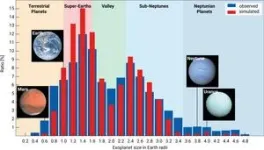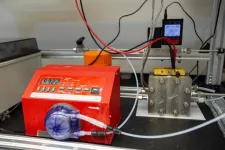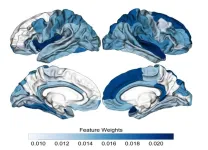(Press-News.org) Ordinarily, planets in evolved planetary systems, such as the Solar System, follow stable orbits around their central star. However, many indications suggest that some planets might depart from their birthplaces during their early evolution by migrating inward or outward. This planetary migration might also explain an observation that has puzzled researchers for several years: the relatively low number of exoplanets with sizes about twice as large as Earth, known as the radius valley or gap. Conversely, there are many exoplanets smaller and larger than this size.
“Six years ago, a reanalysis of data from the Kepler space telescope revealed a shortage of exoplanets with sizes around two Earth radii,” Remo Burn explains, an exoplanet researcher at the Max Planck Institute for Astronomy (MPIA) in Heidelberg. He is the lead author of the article reporting the findings outlined in this article, now published in Nature Astronomy.
Where does the radius valley come from?
“In fact, we – like other research groups – predicted based on our calculations, even before this observation, that such a gap must exist,” explains co-author Christoph Mordasini, a member of the National Centre of Competence in Research (NCCR) PlanetS. He heads the Division of Space Research and Planetary Sciences at the University of Bern. This prediction originated during his tenure as a scientist at MPIA, which has been jointly researching this field with the University of Bern for many years.
The most commonly suggested mechanism to explain the emergence of such a radius valley is that planets might lose a part of their original atmosphere due to the irradiation from the central star – especially volatile gases like hydrogen and helium. “However, this explanation neglects the influence of planetary migration,” Burn clarifies. It has been established for about 40 years that under certain conditions, planets can move inward and outward through planetary systems over time. How effective this migration is and to what extent it influences the development of planetary systems impacts its contribution to forming the radius valley.
Enigmatic sub-Neptunes
Two different types of exoplanets inhabit the size range surrounding the gap. On one hand, there are rocky planets, which can be more massive than Earth and are hence called super-Earths. On the other hand, astronomers are increasingly discovering so-called sub-Neptunes (also mini-Neptunes) in distant planetary systems, which are, on average, slightly larger than the super-Earths.
“However, we do not have this class of exoplanets in the Solar System,” Burn points out. “That’s why, even today, we’re not exactly sure about their structure and composition.”
Still, astronomers broadly agree that these planets possess significantly more extended atmospheres than rocky planets. Consequently, understanding how these sub-Neptunes’ characteristics contribute to the radius gap has been uncertain. Could the gap even suggest that these two types of worlds form differently?
Wandering ice planets
“Based on simulations we already published in 2020, the latest results indicate and confirm that instead, the evolution of sub-Neptunes after their birth significantly contributes to the observed radius valley,” concludes Julia Venturini from Geneva University. She is a member of the PlanetS collaboration mentioned above and led the 2020 study.
In the icy regions of their birthplaces, where planets receive little warming radiation from the star, the sub-Neptunes should indeed have sizes missing from the observed distribution. As these presumably icy planets migrate closer to the star, the ice thaws, eventually forming a thick water vapour atmosphere.
This process results in a shift in planet radii to larger values. After all, the observations employed to measure planetary radii cannot differentiate whether the determined size is due to the solid part of the planet alone or an additional dense atmosphere.
At the same time, as already suggested in the previous picture, rocky planets ‘shrink’ by losing their atmosphere. Overall, both mechanisms produce a lack of planets with sizes around two Earth radii.
Physical computer models simulating planetary systems
“The theoretical research of the Bern-Heidelberg group has already significantly advanced our understanding of the formation and composition of planetary systems in the past,” explains MPIA Director Thomas Henning. “The current study is, therefore, the result of many years of joint preparatory work and constant improvements to the physical models.”
The latest results stem from calculations of physical models that trace planet formation and subsequent evolution. They encompass processes in the gas and dust disks surrounding young stars that give rise to new planets. These models include the emergence of atmospheres, the mixing of different gases, and radial migration.
“Central to this study were the properties of water at pressures and temperatures occurring inside planets and their atmospheres,” explains Burn. Understanding how water behaves over a wide range of pressures and temperatures is crucial for simulations. This knowledge has been of sufficient quality only in recent years. It is this component which permits realistic calculation of the sub-Neptunes’ behaviour, hence explaining the manifestation of extensive atmospheres in warmer regions.
“It’s remarkable how, as in this case, physical properties on molecular levels influence large-scale astronomical processes such as the formation of planetary atmospheres,” Henning adds.
“If we were to expand our results to cooler regions, where water is liquid, this might suggest the existence of water worlds with deep oceans,” Mordasini says. “Such planets could potentially host life and would be relatively straightforward targets for searching for biomarkers thanks to their size.”
Further work ahead
However, the current work is just an important milestone. Although the simulated size distribution closely matches the observed one, and the radius gap is in the right place, the details still have some inconsistencies. For instance, too many ice planets end up too close to the central star in the calculations. Nonetheless, researchers do not perceive this circumstance as a disadvantage but hope to learn more about planetary migration in this way.
Observations with telescopes like the James Webb Space Telescope (JWST) or the under-construction Extremely Large Telescope (ELT) could also assist. They would be capable of determining the composition of planets depending on their size, thus providing a test for the simulations described here.
Background information
The MPIA scientists involved in this study are Remo Burn and Thomas Henning.
Other researchers include Christoph Mordasini (University of Bern, Switzerland [Unibe]), Lokesh Mishra (Université de Genève, Switzerland [Unige], and Unibe), Jonas Haldemann (Unibe), Julia Venturini (Unige), and Alexandre Emsenhuber (Ludwig Maximilian University Munich, Germany, and Unibe).
The NASA Kepler space telescope searched for planets around other stars between 2009 and 2018 and discovered thousands of new exoplanets during its operation. It utilised the transit method: when a planet’s orbit is inclined in a way that the plane lies within the telescope’s line of sight, planets periodically block part of the star’s light during their orbit. This periodic fluctuation in the star’s brightness enables an indirect detection of the planet and determination of its radius.
END
Migration solves exoplanet puzzle
Simulations provide a potential explanation for the mysterious gap in the size distribution of super-Earths.
2024-02-09
ELSE PRESS RELEASES FROM THIS DATE:
New adhesive tape picks up and sticks down 2D materials as easily as child’s play
2024-02-09
Fukuoka, Japan – Materials just atoms in thickness, known as two-dimensional (2D) materials, are set to revolutionize future technology, including in the electronics industry. However, commercialization of devices that contain 2D materials has faced challenges due to the difficulty in transferring these extremely thin materials from where they are made onto the device.
Now, a research team from Kyushu University, in collaboration with Japanese company Nitto Denko, have developed a tape that can be used to stick 2D materials to many different surfaces, in an ...
Researchers discover cosmic dust storms from Type Ia supernova
2024-02-09
Cosmic dust—like dust on Earth—comprises groupings of molecules that have condensed and stuck together in a grain. But the exact nature of dust creation in the universe has long been a mystery. Now, however, an international team of astronomers from China, the United States, Chile, the United Kingdom, Spain, etc., has made a significant discovery by identifying a previously unknown source of dust in the universe: a Type Ia supernova interacting with gas from its surroundings.
The study was published in Nature Astronomy on Feb. 9, and was led by Prof. WANG Lingzhi from the South America Center for Astronomy of the Chinese Academy ...
New fossil site of worldwide importance uncovered in southern France
2024-02-09
Nearly 400 exceptionally well-preserved fossils dating back 470 million years have been discovered in the south of France by two amateur paleontologists. This new fossil site of worldwide importance has been analyzed by scientists from the University of Lausanne, in collaboration with the CNRS and international teams. This discovery provides unprecedented information on the polar ecosystems of the Ordovician period.
Paleontology enthusiasts have unearthed one of the world's richest and most diverse fossil sites from the Lower Ordovician period (around 470 million ...
Global study: Wild megafauna shape ecosystem properties
2024-02-09
For millions of years, a variety of large herbivores, or megafauna, influenced terrestrial ecosystems. Among many others, these included elephants in Europe, giant wombats in Australia, and ground sloths in South America. However, these animals experienced a wave of extinctions coinciding with the worldwide expansion of humans, leading to dramatic but still not fully understood changes in ecosystems. Even the survivors of these extinctions strongly declined, and many are currently threatened with extinction.
While there are many case studies as well as theories about the effects of large animals, formal attempts to quantitatively synthesize their effects and establish ...
Towards A Better Way of Releasing Hydrogen Stored in Hydrogen Boride Sheets
2024-02-09
The looming threat of climate change has motivated scientists worldwide to look for cleaner alternatives to fossil fuels, and many believe hydrogen is our best bet. As an environmentally friendly energy resource, hydrogen (H2) can be used in vehicles and electric power plants without releasing carbon dioxide into the atmosphere.
However, storing and transporting H2 safely and efficiently remains a challenge. Compressed gaseous hydrogen poses a significant risk of explosion and leakage, whereas liquid hydrogen must be maintained at extremely low temperatures, ...
Language barriers could contribute to higher aggression in people with dementia
2024-02-09
Immigrants living with dementia were more likely to present with agitation and aggression compared with their non-immigrant counterparts, a new study by Edith Cowan University (ECU) in collaboration with The Dementia Centre, HammondCare, found.
Researchers from ECU’s Centre for Research in Aged Care and HammondCare’s The Dementia Centre noted that behaviours and psychological symptoms of dementia (BPSD), such as agitation and aggression, are common; however, its presentation may be influenced by the cultural background of the person.
A study investigated differences in clinical and demographics characteristics ...
Conversion process turns greenhouse gas into ethylene
2024-02-09
Engineers at the University of Cincinnati created a more efficient way of converting carbon dioxide into valuable products while simultaneously addressing climate change.
In his chemical engineering lab in UC’s College of Engineering and Applied Science, Associate Professor Jingjie Wu and his team found that a modified copper catalyst improves the electrochemical conversion of carbon dioxide into ethylene, the key ingredient in plastic and a myriad of other uses.
Ethylene has been called ...
Predicting psychosis before it occurs
2024-02-09
The onset of psychosis can be predicted before it occurs, using a machine-learning tool which can classify MRI brain scans into those who are healthy and those at risk of a psychotic episode. An international consortium including researchers from the University of Tokyo, used the classifier to compare scans from over 2,000 people from 21 global locations. About half of the participants had been identified as being clinically at high risk of developing psychosis. Using training data, the classifier was 85% accurate at differentiating between people ...
New research shows students' knowledge and perceptions of active learning declined during pandemic-era teaching
2024-02-09
Students’ knowledge and perceptions of active learning declined significantly during COVID-induced remote teaching and have not recovered to pre-pandemic levels, according to new research from Chapman University Assistant Professor Jeremy Hsu.
Hsu says the benefits of active learning – exercises like group projects, problem-solving and class discussions – are well documented, but he emphasizes that students’ understanding and perceptions of the practice can affect their level of engagement and investment. If students have limited exposure or are hesitant to participate in active learning practices, resistance could ...
Evaluating the performance of AI-based large language models in radiation oncology
2024-02-09
A new study evaluates an artificial intelligence (AI)-based algorithm for autocontouring prior to radiotherapy in head and neck cancer. Manual contouring to pinpoint the area of treatment requires significant time, and an AI algorithm to enable autocontouring has been introduced. The study is published in the peer-reviewed journal AI in Precision Oncology. Click here to read the article now.
Nikhil Thaker, from Capital Health and Bayta Systems, and coauthors, evaluated the performance of various LLMs, including OpenAI’s GPT-3.5-turbo, GPT-4, GPT-4-turbo, ...
LAST 30 PRESS RELEASES:
Exploring how the visual system recovers following injury
Support for parents with infants at pediatric check-ups leads to better reading and math skills in elementary school
Kids’ behavioral health is a growing share of family health costs
Day & night: Cancer disrupts the brain’s natural rhythm
COVID-19 vaccination significantly reduces risk to pregnant women and baby
The role of vaccination in maternal and perinatal outcomes associated with COVID-19 in pregnancy
Mayo Clinic smartwatch system helps parents shorten and defuse children's severe tantrums early
Behavioral health spending spikes to 40% of all children’s health expenditures, nearly doubling in a decade
Digital cognitive behavioral treatment for generalized anxiety disorder
Expenditures for pediatric behavioral health care over time and estimated family financial burden
Air conditioning in nursing homes and mortality during extreme heat
The Alps to lose a record number of glaciers in the next decade
What makes a good proton conductor?
New science reporting guide published for journalists in Bulgaria
New international study reveals major survival gaps among children with cancer
New science reporting guide published for journalists in Turkey
Scientists develop a smarter mRNA therapy that knows which cells to target
Neuroanatomy-informed brain–machine hybrid intelligence for robust acoustic target detection
Eight SwRI hydrogen projects funded by ENERGYWERX
The Lundquist Institute and its start-up company Vitalex Biosciences Announces Strategic Advancement of Second-Generation fungal Vaccine VXV-01 through Phase 1 Trials under $40 Million Competitive Con
Fine particles in pollution are associated with early signs of autoimmune disease
Review article | Towards a Global Ground-Based Earth Observatory (GGBEO): Leveraging existing systems and networks
Penn and UMich create world’s smallest programmable, autonomous robots
Cleveland researchers launch first major study to address ‘hidden performance killer’ in athletes
To connect across politics, try saying what you oppose
Modulating key interaction prevents virus from entering cells
Project explores barriers to NHS career progression facing international medical graduates
Jeonbuk National University researchers explore the impact of different seasonings on the flavor perception of Doenjang soup
Two Keck Medicine of USC Hospitals named Leapfrog Top Teaching Hospitals
World-first discovery uncovers how glioblastoma tumours dodge chemotherapy, potentially opening the door to new treatments
[Press-News.org] Migration solves exoplanet puzzleSimulations provide a potential explanation for the mysterious gap in the size distribution of super-Earths.









